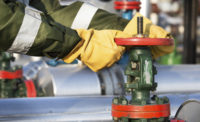 By Bradley King, PhD, MPH, CIH; Eric Esswein, MSPH, CIH; Kyla Retzer, MPH; John Snawder, PhD, DABT; Sophia Ridl, BS; Michael Breitenstein, BS; Marissa Alexander-Scott, DVM, MS, MPH; Ryan Hill, MPH.
By Bradley King, PhD, MPH, CIH; Eric Esswein, MSPH, CIH; Kyla Retzer, MPH; John Snawder, PhD, DABT; Sophia Ridl, BS; Michael Breitenstein, BS; Marissa Alexander-Scott, DVM, MS, MPH; Ryan Hill, MPH.
On May 19th, 2014, NIOSH posted a Science blog titled “Reports of Worker Fatalities during Flowback Operations.” This blog post provided information that NIOSH received from several sources indicating that acute exposures to hydrocarbon gas and vapors likely played a role in the deaths of at least four workers in the oil and gas extraction industry. The four workers were employed in the Williston Basin of North Dakota and Montana. Specific activities the workers had in common at the time of death included manual tank gauging of production tanks or transferring production fluids at the well site.
Since the time of the original blog posting, NIOSH researchers, along with officials from the Occupational Safety and Health Administration (OSHA) and members of the academic community, have continued to investigate these and other reports of worker deaths associated with manual tank gauging and sampling operations in the oil and gas extraction industry. Through this investigation, NIOSH researchers have now identified nine fatalities of oil and gas extraction workers from January 2010 to December 2014 associated with tank gauging or sampling. The degree of detailed information about each case varies but all have in common manually gauging or sampling production tanks at oil and gas well sites. Additionally, the possibility of death caused by exposures to hydrogen sulfide, a toxic gas commonly found in oil and gas formations, was ruled out for these cases. A tool in this ongoing investigation is NIOSH’s Fatalities in the Oil and Gas Extraction Industry (FOG) Database which collects detailed information on fatal events in this industry. NIOSH has recently updated the FOG webpage to include a report that provides further details on each case.
When hatches on production tanks are opened by a worker, a plume of hydrocarbon gases and vapors can be rapidly released due to the internal pressure present in the tank. These gases and vapors can include benzene, a carcinogen, as well as low molecular weight hydrocarbons such as ethane, propane, and butane. In addition to asphyxiation and explosive hazards, exposure to high concentrations of these low molecular weight hydrocarbons can have narcotic effects, resulting in disorientation, dizziness, light-headedness and other effects; recommendations have been made that a maximum exposure limit be set at 10% of the lower explosive limit (LEL) for light hydrocarbon gases in recognition of both the narcotic and explosive hazards.[i],[ii] Case reports of sudden death following butane and propane inhalation have suggested cardiac arrhythmia (irregular heartbeat), hypoxia (a state of insufficient oxygen supply), and respiratory depression (reduced breathing rate and inadequate ventilation of the lungs).[iii]
NIOSH researchers continue to conduct field-based exposure assessment on health risks from exposures to chemicals through the...



